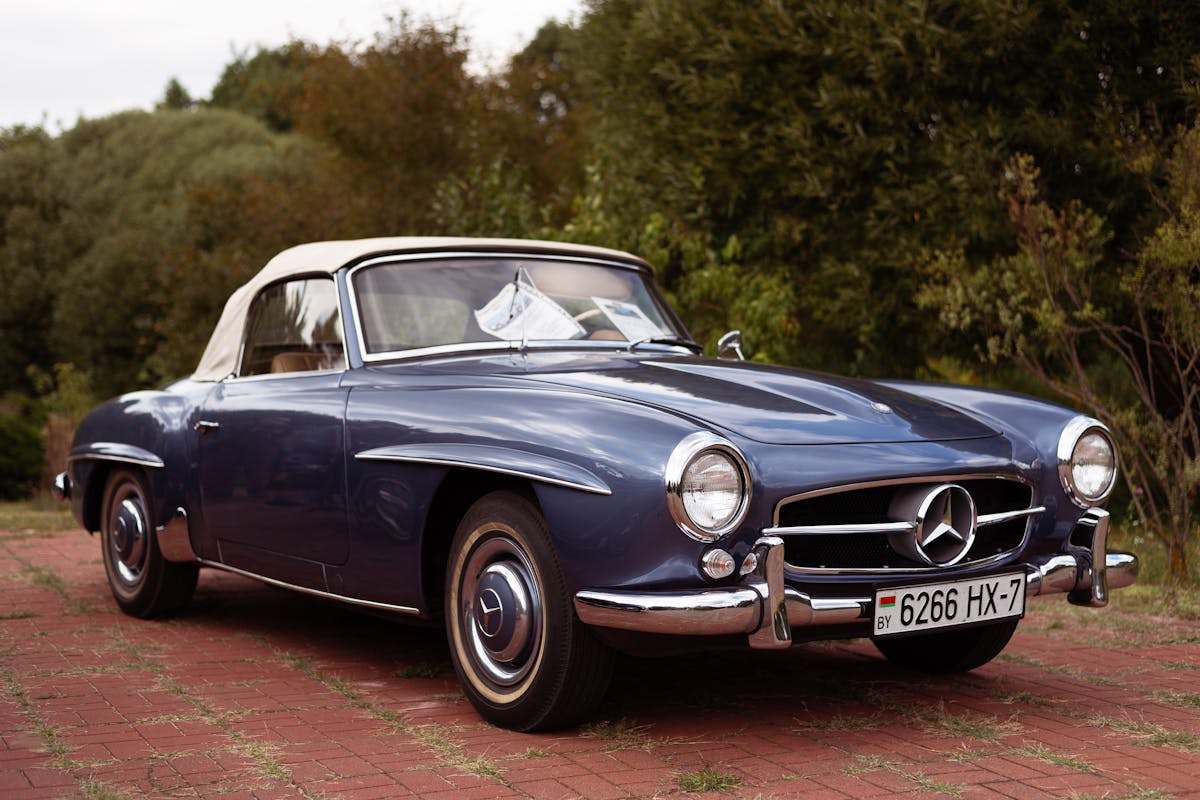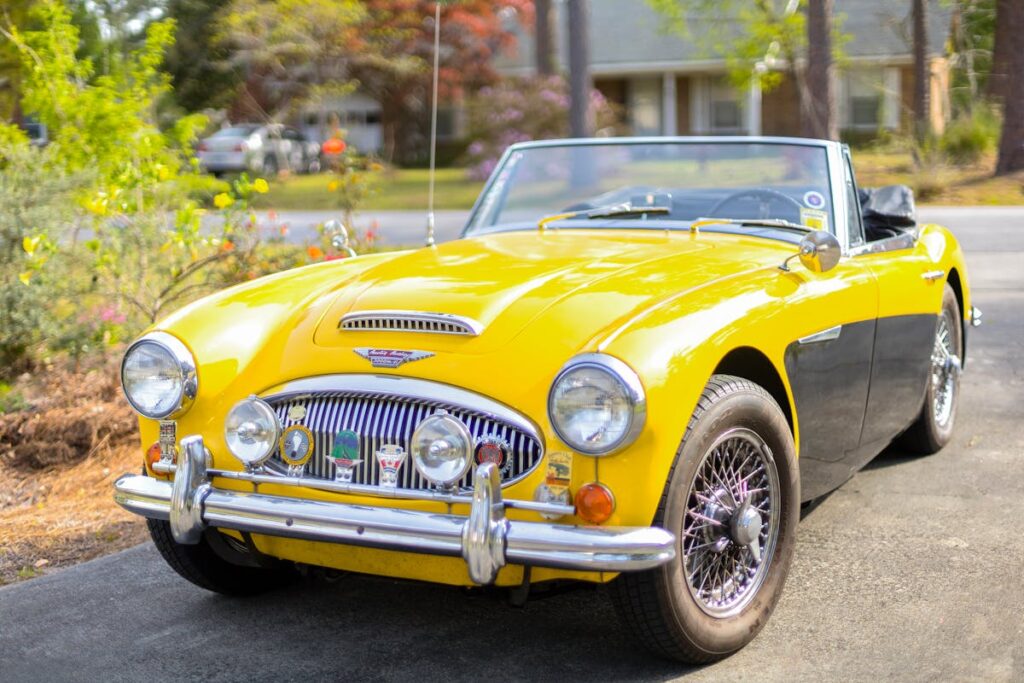For enthusiasts and collectors alike, vintage cars are more than just vehicles; they are priceless treasures that embody history and craftsmanship. Accordingly, storing these automotive marvels poses a unique set of challenges. The delicate balance between preserving original material and preventing degradation requires an intricate understanding of storage solutions. From climate-controlled environments to meticulous maintenance routines and specialized insurance, each aspect plays a crucial role in maintaining the vehicle’s pristine condition. But how can one guarantee the best environment for these vintage gems? Let’s explore this intriguing world of vintage car storage solutions.
Understanding Vintage Car Storage Needs
Frequently, vintage car owners overlook the unique storage needs of their prized possessions. The storage space requirements for these vehicles are distinct from those of modern cars, primarily due to the materials used in their manufacture and their requirement for specific environmental controls.
An integral part of vintage car maintenance involves appropriate storage. Unlike contemporary vehicles, vintage cars are often more susceptible to environmental damage. They require a relatively stable climate to prevent the degradation of their mechanical and aesthetic components. Humidity and temperature changes can cause rust, corrosion, and damage to the paintwork and interior. Consequently, the storage space for these automobiles should ideally be temperature-controlled and well ventilated to avoid moisture buildup.
Moreover, vintage cars typically demand more physical space. This is because they require room for routine maintenance checks, cleaning, and sometimes, restoration projects. The storage space should also allow for easy maneuverability around the vehicle to prevent accidental scratches or damage.
Indoor Vs Outdoor Storage
The choice between indoor and outdoor storage for vintage cars is a significant one, each presenting its unique set of advantages and potential drawbacks. Indoor storage, while often more costly, offers benefits such as protection from weather and potential damage from external factors. On the contrary, outdoor storage, although more affordable, comes with risks such as exposure to elements and increased potential for harm, which must be thoroughly considered.
Benefits of Indoor Storage
Opting for indoor storage offers a myriad of benefits that can considerably contribute to the longevity and aesthetic appeal of your vintage car. This choice is a proactive measure that aligns perfectly with effective restoration techniques and maintenance routines, both of which are integral to upholding the vintage car’s value and charm.
Indoor storage provides a controlled environment that shields your vintage car from detrimental external elements, such as harsh weather conditions and UV radiation. It also reduces the exposure to corrosive agents, hence preventing rust and wear. This is particularly beneficial for vintage cars, whose spare parts may be challenging to find or expensive to acquire.
Indoor storage facilities often have superior security measures in place, reducing the risk of theft or vandalism. In addition, they offer a clean, dust-free environment that is conducive to the preservation of your car’s paintwork and interior fabrics.
Risks of Outdoor Storage
While indoor storage clearly offers impressive advantages for vintage car owners, it is also important to understand the potential risks associated with outdoor storage. One such risk is wildlife damage. Animals seeking shelter or food might gnaw on wires, upholstery, or other car parts, leading to costly repairs.
Theft risks are also heightened in outdoor storage conditions, with the valuable vehicle more visible and accessible to potential criminals. Adequate security measures are essential to mitigate this threat.
Another significant concern is moisture buildup, which can accelerate rusting and degradation of metal components, impairing the vehicle’s structural integrity. Similarly, UV exposure can cause fading and deterioration of paint, rubber, and leather components, altering the car’s original aesthetics.
Outdoor storage also exposes the vehicle to temperature fluctuations, which can lead to mechanical issues. Cold temperatures can cause the oil to thicken, making it harder for the engine to start, while extreme heat can cause the battery to drain faster.
Lastly, pest infestations pose a risk to outdoor-stored cars. Insects and rodents can nest in the vehicle’s nooks and crannies, causing extensive damage. As a result, outdoor storage necessitates thorough strategies to protect the vehicle from these potential risks.
Climate-Controlled Storage Benefits
Climate-controlled storage offers distinct advantages for vintage cars, particularly in the preservation of the vehicle’s physical condition. By providing a controlled environment, these storage solutions offer protection against weather extremes that may cause detrimental effects such as rust and corrosion. Hence, in the context of vintage cars, where maintaining the vehicle’s originality is paramount, climate-controlled storage becomes an invaluable tool.
Preserving Car’s Physical Condition
The preservation of a vintage car’s physical integrity hinges largely on the choice of storage. A climate-controlled environment is vital as it provides consistent, ideal conditions, reducing the risk of damage associated with fluctuating temperatures and humidity levels. However, additional measures are necessary to maintain the car’s pristine condition.
A high-quality car cover, specifically designed for vintage cars, is an indispensable tool. It guards against dust and minor physical disturbances. It should be breathable to prevent moisture build-up, soft-lined to avoid scratching the paintwork, and tailored to fit snugly over the vehicle. Regular inspections are instrumental in preserving the car’s physical condition, as they help detect and address issues before they escalate. These inspections should include cleaning the car, checking for rust, inspecting the undercarriage, and making sure the tires are properly inflated.
Moreover, the car’s mechanical components require attention as well. Regularly starting the vehicle and allowing it to run for a few minutes can help keep the engine in working order. Finally, the vehicle should be moved periodically to prevent flat spots on the tires. By adhering to these guidelines, one can guarantee the longevity and preservation of a vintage car’s physical condition.
Protection Against Weather Extremes
In view of the above, protecting vintage cars from weather extremes further underscores the importance of climate-controlled storage. The primary objective of this storage solution is to maintain a consistent, ideal environment for vintage cars, shielding them from fluctuating weather conditions that could lead to irreparable damage.
Weatherproof covers are a standard component of this strategy, providing a first-line defense against harmful elements. Whilst they offer protection from direct sunlight, wind, and precipitation, their effectiveness is limited when it comes to regulating temperature and humidity. This is where climate-controlled storage comes into play, providing a thorough solution that goes beyond surface-level protection.
Climate-controlled storage units utilize advanced technology to regulate temperature and humidity levels, maintaining a steady environment that prevents weather-related decay. Humidity control is particularly vital, as excessive moisture can cause damage to the car’s interior and exterior. These storage units create a barrier against weather extremes, ensuring that the vintage cars are not subjected to conditions that could compromise their condition.
Preventing Rust and Corrosion
Shifting gears to another significant benefit of climate-controlled storage, it particularly aids in preventing rust and corrosion. Rust is a vintage car’s worst enemy, capable of quickly destroying bodywork and components. As rust favours a damp environment, the use of climate-controlled storage creates an ideal condition for preventing its formation.
The climate-controlled storage environment maintains a consistent temperature and humidity level, diminishing the risk of condensation, a primary catalyst for rust. Within this setting, the application of rust inhibitors can further enhance protection. These substances work by creating a barrier on the car’s metal surfaces, effectively blocking the chemical reaction needed for rust to form.
Similarly, corrosion treatment is another vital advantage of climate-controlled storage. Corrosion, like rust, thrives in moisture-laden settings. By regulating humidity and temperature, these storage solutions help to prevent the onset of this destructive process. Furthermore, specific corrosion treatments can be applied more effectively in such controlled environments, fortifying the material against corrosive damage.

Temporary Storage Options
For vintage car enthusiasts with a need for short-term storage, several viable options exist. One such option is garage rentals. Renting a garage offers a secure, controlled environment that can protect your car from the elements. Many facilities also provide features such as climate control, which can be beneficial in maintaining the vehicle’s condition. Be sure to inquire about the facility’s security measures, such as surveillance systems and access control, to guarantee the safety of your vintage car.
Another temporary storage option is mobile storage. This involves a storage unit being delivered to your location, which you can fill at your leisure. Once filled, the unit is picked up and stored at a secure facility. This is a flexible solution that provides door-to-door service, eliminating the need for you to transport your vehicle. It’s particularly useful if your vintage car isn’t in running condition or if you’re concerned about driving it on public roads.
Long-Term Storage Solutions
A considerable number of long-term storage solutions exist for vintage car owners seeking to preserve their prized possessions over extended periods. These options cater to different needs, ranging from guaranteeing restoration readiness to providing storage accessibility.
One such solution is climate-controlled storage units. These units maintain a consistent temperature and humidity level, preventing rust and corrosion. They are ideal for car owners who are preparing for extensive restoration and want their vehicle in a controlled environment.
Another option is specialized car storage facilities. These cater specifically to vintage car owners, providing services tailored to the unique needs of these vehicles. They offer high storage accessibility, allowing owners to check on their cars or take them out for a spin whenever they wish.
Car capsules, an innovative solution, provide an enclosed, air-circulated space for your car, shielding it from dust and moisture. They are portable and can be used in your garage, offering a blend of accessibility and protection.
Lastly, car owners may opt for professional restoration shops that offer long-term storage. These facilities guarantee restoration readiness by regularly maintaining your car while in storage. Choose a solution that best fits your car’s condition, your budget, and accessibility needs.
Security Measures for Vintage Cars
Ensuring the security of one’s vintage car is of paramount importance, given the intrinsic and sentimental value these vehicles often hold. The implementation of advanced security features is an essential step in theft prevention, safeguarding your assets from potential criminal activity.
Monitoring systems play a key role in this regard. They provide 24/7 surveillance of your vehicle, alerting you to any unauthorized activity. Surveillance cameras are commonly used in conjunction with these systems, offering visual evidence that can aid in the recovery of the vehicle should a theft occur.
Access control is another important aspect. Robust lock systems and physical barriers such as gates or bollards can deter would-be thieves, making it more difficult for them to gain access to your vehicle. Secure parking, ideally in a private garage or gated compound, further enhances your vehicle’s security.
Alarm systems are also beneficial. These systems can deter thieves and alert nearby people to a potential theft in progress.
Lastly, adequate insurance coverage is invaluable. While it can’t prevent theft, it can provide financial protection in the event of a loss.
Maintaining Your Car While Stored
Preserving the operational integrity of your vintage car during storage requires meticulous attention to detail. Foremost on the list are battery maintenance and tire care. Disconnecting the battery helps prevent damage from long-term inactivity, while inflating tires to their maximum rating can prevent flat spots. Regular inspections should be conducted to guarantee that these measures remain effective.
Fuel stabilization is another key element. Over time, fuel can degrade, leading to engine problems. A quality fuel stabilizer can prevent such issues, securing smooth operation upon retrieval. Fluid checks, too, are essential. Regularly inspecting and topping up necessary fluids – including oil, brake fluid, and coolant – can prevent corrosion and other damage.
The right cleaning techniques play an important role in maintaining the car’s aesthetic appeal. A thorough cleaning before storage helps prevent rust and corrosion. Similarly, appropriate cover selection is imperative. A breathable, custom-fit cover will protect the paintwork and prevent moisture accumulation.
Lastly, pest prevention should not be overlooked. Rodents can cause significant damage to upholstery and wiring. Using deterrents and sealable storage can help preserve your vintage vehicle in its pristine condition.
Insurance and Vintage Car Storage
Securing the right insurance coverage for your vintage car stored long-term is a critical aspect of safeguarding your investment. This process involves understanding the different insurance types and exploring various coverage options.
Classic car insurance is a specialized type of coverage designed specifically for the unique needs of vintage and classic car owners. This insurance type often offers better coverage at a lower price compared to standard auto insurance. However, the specifics can vary considerably among providers, so it’s vital to shop around and compare policies.
Coverage options often include agreed value coverage, which guarantees the car’s full insured value with no depreciation in the event of a total loss. Other options may encompass spare parts coverage, which can be particularly important given the rarity and cost of vintage car parts.
Additionally, consider if your chosen storage solution impacts your insurance. Some insurers may offer discounts if your car is stored in a secure, climate-controlled facility. Others may require additional coverage for cars stored long-term.
Frequently Asked Questions
What Are Affordable Vintage Car Storage Solutions for Low-Income Owners?
Affordable options for vintage car owners include budget-friendly public storage facilities and DIY storage solutions, such as custom-built garages or carports, which provide protection and security without considerably impacting the owner’s finances.
Can I Store My Vintage Car in a Regular Garage?
Yes, a regular garage can be utilized for storing a vintage car. However, proper garage organization and measures for vehicle protection, such as dust covers and moisture control, should be implemented to preserve the car’s condition.
Are There Any Specific Storage Solutions for Vintage Motorcycles?
Yes, vintage motorcycles require specific storage solutions. Ideal methods include routine motorcycle maintenance and the use of protective covers to safeguard against environmental factors, ensuring preservation of the motorcycle’s original condition and value.
What Are the Risks of Not Using a Climate-Controlled Storage?
Not utilizing climate-controlled storage exposes valuable assets to potential humidity damage and temperature fluctuations. This can lead to detrimental effects such as corrosion, paint damage, and the degradation of leather or rubber components.
How Does a Vintage Cars Value Change With Different Storage Conditions?
Different storage conditions considerably impact a vintage car’s value. Poor environments may expedite value depreciation, while ideal, climate-controlled conditions can maintain and potentially enhance value by ensuring storage longevity and minimizing damage.

